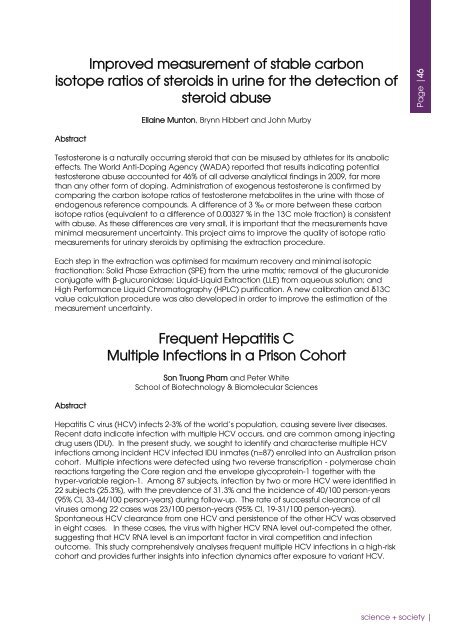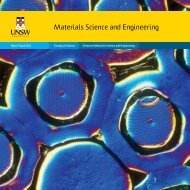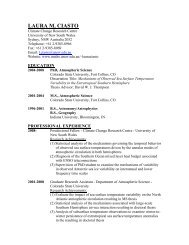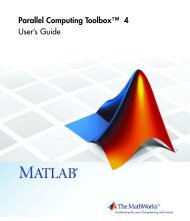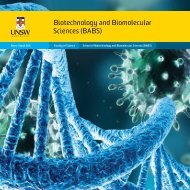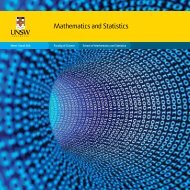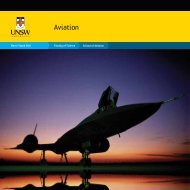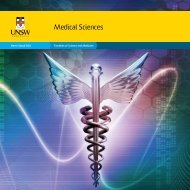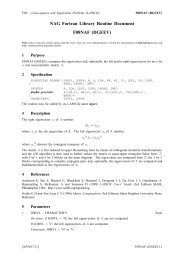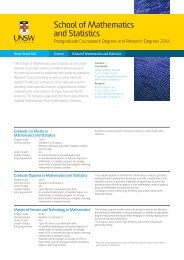2011 Postgraduate Research Competition - UNSW Science - The ...
2011 Postgraduate Research Competition - UNSW Science - The ...
2011 Postgraduate Research Competition - UNSW Science - The ...
You also want an ePaper? Increase the reach of your titles
YUMPU automatically turns print PDFs into web optimized ePapers that Google loves.
Page |46<br />
Improved measurement of stable carbon<br />
isotope ratios of steroids in urine for the detection of<br />
steroid abuse<br />
Ellaine Munton, Brynn Hibbert and John Murby<br />
Abstract<br />
Testosterone is a naturally occurring steroid that can be misused by athletes for its anabolic<br />
effects. <strong>The</strong> World Anti-Doping Agency (WADA) reported that results indicating potential<br />
testosterone abuse accounted for 46% of all adverse analytical findings in 2009, far more<br />
than any other form of doping. Administration of exogenous testosterone is confirmed by<br />
comparing the carbon isotope ratios of testosterone metabolites in the urine with those of<br />
endogenous reference compounds. A difference of 3 ‰ or more between these carbon<br />
isotope ratios (equivalent to a difference of 0.00327 % in the 13C mole fraction) is consistent<br />
with abuse. As these differences are very small, it is important that the measurements have<br />
minimal measurement uncertainty. This project aims to improve the quality of isotope ratio<br />
measurements for urinary steroids by optimising the extraction procedure.<br />
Each step in the extraction was optimised for maximum recovery and minimal isotopic<br />
fractionation: Solid Phase Extraction (SPE) from the urine matrix; removal of the glucuronide<br />
conjugate with β-glucuronidase; Liquid-Liquid Extraction (LLE) from aqueous solution; and<br />
High Performance Liquid Chromatography (HPLC) purification. A new calibration and δ13C<br />
value calculation procedure was also developed in order to improve the estimation of the<br />
measurement uncertainty.<br />
Abstract<br />
Frequent Hepatitis C<br />
Multiple Infections in a Prison Cohort<br />
Son Truong Pham and Peter White<br />
School of Biotechnology & Biomolecular <strong>Science</strong>s<br />
Hepatitis C virus (HCV) infects 2-3% of the world’s population, causing severe liver diseases.<br />
Recent data indicate infection with multiple HCV occurs, and are common among injecting<br />
drug users (IDU). In the present study, we sought to identify and characterise multiple HCV<br />
infections among incident HCV infected IDU inmates (n=87) enrolled into an Australian prison<br />
cohort. Multiple infections were detected using two reverse transcription - polymerase chain<br />
reactions targeting the Core region and the envelope glycoprotein-1 together with the<br />
hyper-variable region-1. Among 87 subjects, infection by two or more HCV were identified in<br />
22 subjects (25.3%), with the prevalence of 31.3% and the incidence of 40/100 person-years<br />
(95% CI, 33-44/100 person-years) during follow-up. <strong>The</strong> rate of successful clearance of all<br />
viruses among 22 cases was 23/100 person-years (95% CI, 19-31/100 person-years).<br />
Spontaneous HCV clearance from one HCV and persistence of the other HCV was observed<br />
in eight cases. In these cases, the virus with higher HCV RNA level out-competed the other,<br />
suggesting that HCV RNA level is an important factor in viral competition and infection<br />
outcome. This study comprehensively analyses frequent multiple HCV infections in a high-risk<br />
cohort and provides further insights into infection dynamics after exposure to variant HCV.<br />
science + society |


